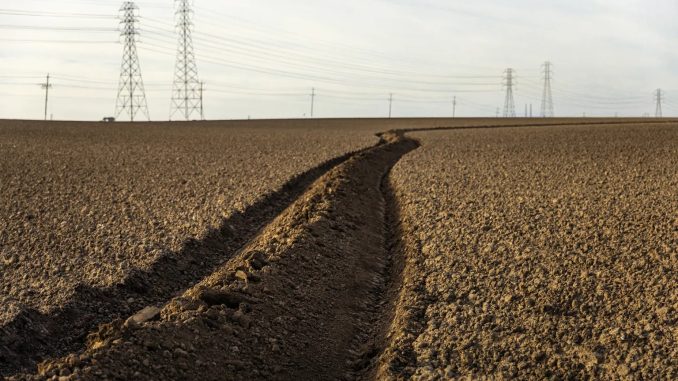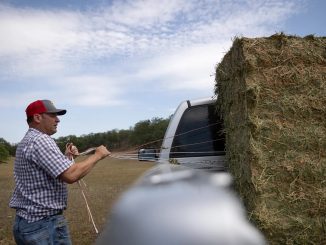
This story on a dangerous herbicide banned by the EPA was produced by CalMatters, an independent public journalism venture covering California politics and government. For more info, visit calmatters.org.
By Rachel Becker (for CalMatters)
A dangerous herbicide banned immediately by the US Environmental Protection Agency has been sprayed on crops in many California counties and has contaminated groundwater in low concentrations in the Salinas Valley and Santa Barbara County.
The weed-killing chemical, known as DCPA or Dacthal, can harm the developing brains of babies in the womb, and can remain in farm fields for weeks, EPA officials said. The greatest threat is to pregnant farmworkers and those who live near fields.
The chemical, which has been in use in the United States for almost 70 years, was so dangerous that “it needs to be removed from the market immediately,” EPA announced Tuesday. The agency issued a rare emergency order suspending all use immediately — a first for the EPA in almost 40 years.
“It’s EPA’s job to protect people from exposure to dangerous chemicals. In this case, pregnant women who may never even know they were exposed could give birth to babies that experience irreversible lifelong health problems,” Assistant Administrator for the Office of Chemical Safety and Pollution Prevention Michal Freedhoff said in a statement Tuesday.
The move, however, comes more than a year after the EPA released findings that the pesticide could harm unborn babies by altering fetal thyroid levels. “These changes are generally linked to low birth weight, impaired brain development, decreased IQ, and impaired motor skills later in life, some of which may be irreversible,” the agency said.
Advocates say the herbicide should have been banned years ago because federal and California officials have long known its health risks. The EPA has deemed it a “possible human carcinogen” since the 1990s, and the European Union banned it 15 years ago.
Environmental Working Group Senior Toxicologist Alexis Temkin called the emergency order “welcome news, but it’s long overdue.”
Used to kill weeds on farms and, until recently, grassy fields like golf courses, the pesticide is largely used on broccoli, onions, Brussels sprouts and cabbage.
Much of the chemical is applied in California: The latest federal data tallied less than half a million pounds used nationwide in 2018. California growers, according to state totals, used nearly 200,000 pounds in both 2021 and 2022.
The heaviest use is in Monterey County. Researchers at UC Berkeley found that more than half of nearly 100 Latina girls between the ages of 14 and 16 living in farmworker communities in the Salinas Valley were exposed to DCPA.
According to state data, other counties with the largest usage include Imperial, Fresno, Riverside, Santa Barbara, San Luis Obispo, Kern and Ventura.
The California Department of Pesticide Regulation told CalMatters that it didn’t have enough information to take action on its own to ban DCPA. “The department would have had to conduct the same risk assessment, mitigation development and regulatory steps U.S. EPA had already initiated and has now completed, which would have taken months to years for DPR to complete,” said Leia Bailey, the department’s deputy director of communications and outreach.
Traces of the herbicide have appeared in groundwater in California farm regions. The state Department of Pesticide Regulation detected chemicals formed when DCPA breaks down at concentrations of between 66 to 159 parts per billion in three wells near Guadalupe in Santa Barbara County — equivalent to up to about 159 drops in an Olympic-sized swimming pool. Levels in the Salinas Valley reached 101 parts per billion in one well near Greenfield.
The levels in groundwater were “well below the health-protective drinking water level” set by California’s environmental health agency. The state public health advisory, however, was set before recent studies showed birth effects.
Amy Gilson, a spokesperson for California’s Office of Environmental Health Hazard Assessment, told CalMatters today that the 2018 assessment “used the best available evidence at the time.” She said the EPA’s emergency order was based on a 2022 thyroid study by AMVAC Chemical Corp., the manufacturer. “We greatly appreciate the US EPA’s efforts to advance the science on DCPA’s toxicity and their action to protect people from its effects.”
Most of the risk is to farmworkers and people near the sprayed fields, EPA officials say. People handling the chemicals could be exposed to levels far higher than deemed safe, especially for pregnant individuals. Those weeding, transplanting or harvesting could also be at risk even after the pesticide has been applied: though the instructions call for people to stay out of treated fields for 12 hours, the EPA reported that levels remain unsafe for at least 25 days. Nearby residents are at risk from spray drift, as well.
A representative of AMVAC, which is based in Newport Beach, told CalMatters that they are complying with the EPA’s order and had already voluntarily withdrawn the weedkiller from the market in May.
“We have worked with them, and we will continue to work with them. We want to make sure that our customers don’t use the products, obviously … It’s not like we’re fighting this, if you will, per se. It’s an announcement that’s come from the government, and we are fully complying with it,” said Anthony Young, director of investor relations.
The EPA’s decision follows its review of AMVAC’s study of pregnant rats that showed thyroid hormone changes, which, extrapolated to humans, could lead to permanent effects on a baby’s brain. In chemical studies, rodents are often exposed to high levels for short periods to mimic human exposure.
The EPA had been pushing AMVAC, to submit data on the chemical since 2013, including a study on thyroid function in fetuses and children. But the company missed key deadlines by years, forcing the EPA to issue a temporary suspension.
In May 2023, after reviewing the thyroid study submitted in 2022, the agency released its health assessment of the chemical and reported that even with personal protective equipment and other measures, the health risks persisted, especially for unborn babies and pregnant people. In December, the company voluntarily withdrew the chemical for use on turf, according to the EPA.
The emergency order comes four months after the EPA warned farmworkers of the dangers and said it would be taking steps to address the “serious, permanent, and irreversible health risks associated with the pesticide as quickly as possible.”



Be the first to comment